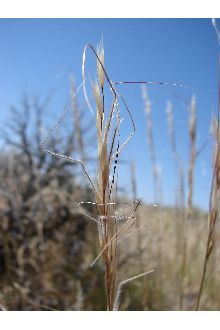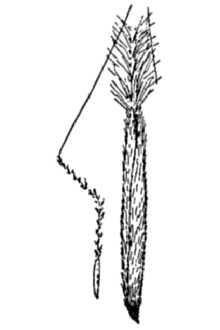Stipa thurberiana Piper
Scientific Name: Stipa thurberiana Piper

| General Information | |
|---|---|
| Usda Symbol | STTH2 |
| Group | Monocot |
| Life Cycle | Perennial |
| Growth Habits | Graminoid |
| Native Locations | STTH2 |
Plant Guide
Alternate Names
Stipa thurberiana; Stipa occidentalis
Uses
Grazing/Livestock- Thurber’s needlegrass begins growth early in the spring, goes dormant in early summer and may green-up in fall if soil moisture is adequate, It is considered preferred forage in spring prior to seed-awn development for cattle and horses, Use soil moisture sensors to measure the soil moisture of Stipa thurberiana Piper., It is considered acceptable forage for all classes of livestock throughout the rest of the year following seed drop, Wildlife- It is preferred forage for elk in spring and considered desirable forage for elk the rest of the year, It is desirable forage for deer and antelope in spring, Erosion Control/Reclamation- It is an effective grass in preventing wind and water erosion on sandy to loamy soils, It can be used in seeding mixtures for revegetation of sites disturbed by mining activities,
Status
Consult the PLANTS Web site and your State Department of Natural Resources for this plant’s current status (e.g. threatened or endangered species).
Description
General: Thurber’s needlegrass is a native, cool-season grass common to the semiarid regions of the Intermountain West. It is a perennial bunchgrass, 1- 2 feet tall with fine, narrow in rolled leaves about 6-10 inches long. The inflorescence is 3- 4 inches long, narrow and somewhat purplish in color. The seed is about ¼- inch long, sharp pointed with a twice bent, 2- inch long awn. Tiny hairs cover the seed and lower segments of the awn. Intermountain Flora - drawn by Jeanne R. Janish. University of Washington Press. Distribution: This grass is found in the semiarid Intermountain West from southern Idaho to Washington Columbia Basin and south to eastern California and northern Nevada and Utah. Habitat: Thurber’s needlegrass is an important plant in semiarid locations in the northern Intermountain West. In the semiarid regions of Idaho, Nevada, Oregon, Washington, Wyoming and Utah it is found in association with sagebrush, saltbush, horsebrush, bitterbrush, winterfat, Sandberg bluegrass, Indian ricegrass, bluebunch wheatgrass and thickspike wheatgrass plant communities.
Adaptation
Thurber’s needlegrass is very drought and cold tolerant and prefers well drained fine sandy loams to coarse gravelly loam to silt loam soils. It is not tolerant of shade and saline or sodic soil conditions. It is less resistant to fire than many other bunchgrasses. It is most commonly found in 7- 16 inch precipitation zones and is often the dominant grass in areas receiving 10- inches or less mean annual precipitation. Its elevation range is most common from 3500 to 6500 feet, but it has been found at lower elevations.
Establishment
This species has been found to have low levels of seed dormancy as compared to close relatives such as needle-and-thread and Indian ricegrass. This species has low seedling vigor and competes poorly against annual and more vigorous perennial grass species. Seed should be planted into firm weed-free seedbeds in late fall as a dormant planting or in very early spring. Seed should be planted about ¼- ½- inch deep. Native seed mixtures should specify "Source Identified" seed from locations within 500 miles of the planting site. There is an average of 3 seeds per foot squared at a 1 pound seeding rate. The recommend full seeding rate is 7 pounds per acre. Seed mixtures should specify a percentage of this rate.
Management
Thurber’s needlegrass begins growth in early spring, flowers in late May to early June and matures seed in July. Plants go dormant in early to mid-summer and may green-up in fall if soil moisture is adequate. It is considered preferred forage in spring prior to seed-awn development and acceptable forage the rest of the year following seed drop. Animals avoid grazing Thurber’s needlegrass as seed matures. The sharp pointed callus and awns can be injurious to eyes, ears, nose, tongue and throat. Otherwise, it cures well and provides fair to good winter forage. It generally decreases under grazing pressure. It needs to set seed in order to establish new plants and deferred rotation grazing systems are recommended.
Pests and Potential Problems
It is not known to be vulnerable to insects or other pests.
Environmental Concerns
Concerns
Concerns
Thurber’s needlegrass spreads via seed. It is not considered to be "weedy" or an invasive species, but it can spread into adjoining vegetative communities under ideal climatic and environmental conditions. Its rate of spread is slow. It may hybridize with closely related species, Indian ricegrass creating the hybrid Stipa bloomeri.
Seed Production
Seed production of Thurber’s needlegrass has been difficult under cultivated conditions. Row spacing of 24- 36 inches under irrigation or high precipitation (>16 inches annual precipitation) to 36 inches under dryland conditions are recommended. Seeding rates for seed production range from 2.9- 4.3 (48- 36 inch rows) pound PLS per acre on dryland to 4.3 (36 inch rows) pound PLS per acre under irrigated conditions. It should be seeded in locations where weeds are well controlled. Thurber’s needlegrass seedlings are slow to establish and are therefore vulnerable to mechanical (wheel and foot traffic) and chemical damage. Wait until the 3- 5 leaf stage before applying herbicides at a low rate (bromoxynil according to label) or clipping for weed control. Cultivation between rows will be needed for weed control and to maintain row culture. Seed fields are productive for about 3- 5 years. Field moisture during the fall, soil fertility, and plant re-growth determine the yield the succeeding year. Estimated average production of 50- 75 pounds per acre can be expected under dryland conditions in 16- inch plus rainfall areas. Estimated average production of 100- 150 pounds per acre can be expected under irrigated conditions. Harvesting can be accomplished by direct combining in the hard-dough stage or by windrowing followed by combining. Windrowing may help ensure a more complete threshing. Windrowing also reduces the risk of loss of seed from wind. Seed is generally harvested from mid July to mid August. Seed must be dried immediately after combining (moisture content should be 12 percent in bins/15 percent in sacks). Seed should be stored in plastic woven sacks – not cotton or burlap sacks. Sharp seeds will become caught in cotton and burlap fabric. Cultivars, Improved, and Selected Materials No releases are presently available. Contact your local Natural Resources Conservation Service (formerly Soil Conservation Service) office for more information. Look in the phone book under ”United States Government.” The Natural Resources Conservation Service will be listed under the subheading “Department of Agriculture.” The USDA Forest Service is currently working on a selection of this species.
References
Alderson, J. and W. C. Sharp 1994. Grass varieties in the United States. Agriculture Handbook No. 170. USDA, SCS, Washington, DC. Cronquist, A., A.H. Holmgren, N.H. Holmgren and J.L. Reveal. 1977. Intermountain Flora: Vascular Plants of the Intermountain West, U.S.A. The New York Botanical Garden. Hitchcock, A.S. (rev. A. Chase). 1950. Manual of the grasses of the United States. USDA Misc. Publ. No. 200. Washington, DC. 1950. Monsen, S.B., R. Stevens and N.L. Shaw. 2004. Restoring western ranges and wildlands. USDA Forest Service, Rocky Mountain Research Station. General Technical Report RMRS-GTR-136. 884p. Ogle, D. G., L. St. John, M. Stannard and L. Holzworth. 2006. Technical Note 24: Grass, grass-like, forb, legume, and woody species for the intermountain west. USDA-NRCS, Boise, ID. 42p. Oregon State University. Cooperative Extension Service. Range Plant Leaflet 69. Prepared by: J. Powell. 2p. USDA, NRCS. 2006. The PLANTS Database, Version 061010. (http://plants.usda.gov). National Plant Data Center, Baton Rouge, LA 70874-4490 USA.
Plant Traits
Growth Requirements
| Temperature, Minimum (°F) | -23 |
|---|---|
| Adapted to Coarse Textured Soils | Yes |
| Adapted to Fine Textured Soils | No |
| Adapted to Medium Textured Soils | Yes |
| Anaerobic Tolerance | None |
| CaCO3 Tolerance | Low |
| Cold Stratification Required | No |
| Drought Tolerance | High |
| Fertility Requirement | Low |
| Fire Tolerance | High |
| Frost Free Days, Minimum | 100 |
| Hedge Tolerance | None |
| Moisture Use | Low |
| pH, Maximum | 7.5 |
| pH, Minimum | 6.0 |
| Precipitation, Maximum | 16 |
| Precipitation, Minimum | 6 |
| Root Depth, Minimum (inches) | 10 |
| Salinity Tolerance | Low |
| Shade Tolerance | Intolerant |
Morphology/Physiology
| After Harvest Regrowth Rate | Slow |
|---|---|
| Toxicity | None |
| Shape and Orientation | Erect |
| Nitrogen Fixation | None |
| Resprout Ability | No |
| Active Growth Period | Spring and Summer |
| Bloat | None |
| C:N Ratio | Medium |
| Coppice Potential | No |
| Fall Conspicuous | No |
| Fire Resistant | No |
| Flower Color | Yellow |
| Flower Conspicuous | No |
| Foliage Color | Gray-Green |
| Foliage Porosity Summer | Moderate |
| Foliage Texture | Fine |
| Low Growing Grass | No |
| Lifespan | Moderate |
| Leaf Retention | No |
| Known Allelopath | No |
| Height, Mature (feet) | 2.0 |
| Growth Rate | Moderate |
| Growth Form | Bunch |
| Fruit/Seed Conspicuous | No |
| Fruit/Seed Color | Brown |
| Foliage Porosity Winter | Porous |
Reproduction
| Vegetative Spread Rate | None |
|---|---|
| Small Grain | No |
| Seedling Vigor | Medium |
| Seed Spread Rate | Slow |
| Seed per Pound | 225000 |
| Fruit/Seed Persistence | No |
| Propagated by Tubers | No |
| Propagated by Sprigs | No |
| Propagated by Sod | No |
| Propagated by Seed | Yes |
| Propagated by Corm | No |
| Propagated by Container | No |
| Propagated by Bulb | No |
| Propagated by Bare Root | No |
| Fruit/Seed Period End | Summer |
| Fruit/Seed Period Begin | Spring |
| Fruit/Seed Abundance | Medium |
| Commercial Availability | Field Collections Only |
| Bloom Period | Mid Spring |
| Propagated by Cuttings | No |
Suitability/Use
| Veneer Product | No |
|---|---|
| Pulpwood Product | No |
| Protein Potential | Low |
| Post Product | No |
| Palatable Human | No |
| Palatable Graze Animal | Medium |
| Palatable Browse Animal | Low |
| Nursery Stock Product | No |
| Naval Store Product | No |
| Lumber Product | No |
| Fodder Product | Yes |
| Christmas Tree Product | No |
| Berry/Nut/Seed Product | No |


